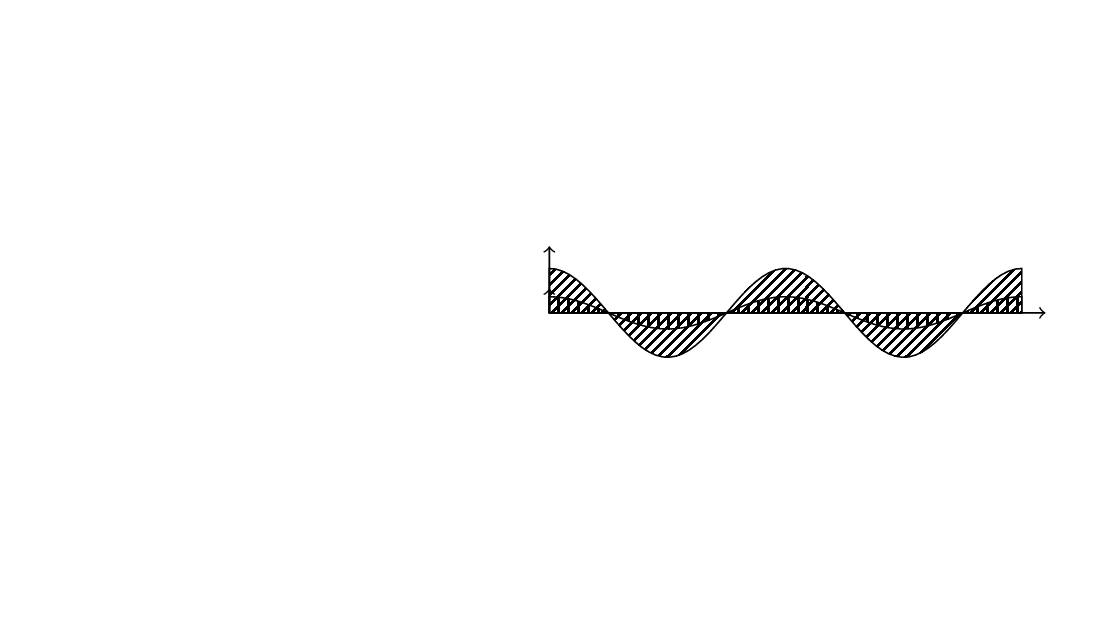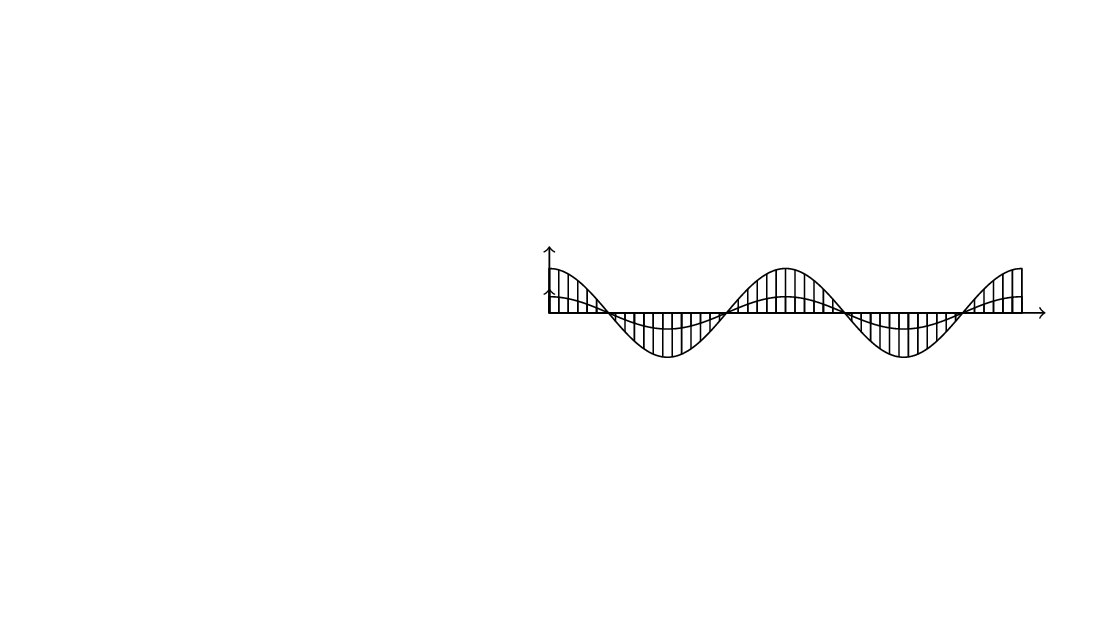How to fit the filling pattern to the z axis in tikz?
Here is an alternative to Zarko's nice answer with shorter code and a more wave-like wave, i.e. the first maximum as wide as the other ones.
\documentclass[tikz,margin=2mm]{standalone}
\usepackage{tikz}
\usetikzlibrary{patterns}
\begin{document}
\begin{tikzpicture}
\draw[->] (0,0,0) -- (10.5,0,0);
\draw[->] (0,0,0) -- (0,1.5,0);
\draw[->] (0,0,0) -- (0,0,1.5);
\draw[pattern=vertical lines] (0,0,0) -- plot[variable=\x,domain=0:10,samples=72] (\x,{cos(72*\x)},0)
-- (10,0,0) -- cycle;
\draw[pattern=north east lines] (0,0,0) -- plot[variable=\x,domain=0:10,samples=72] (\x,0,{cos(72*\x)}) -- (10,0,0) -- cycle;
\end{tikzpicture}
\end{document}

EDIT: Just saw your comment under Zarko's nice answer. Probably Zarko means the tikz-3dplot package, the link is correct, and here is an animation illustrating his point.
\documentclass[tikz,margin=3.14mm]{standalone}
\usepackage{tikz-3dplot}
\usetikzlibrary{patterns}
\begin{document}
\foreach \X in {0,5,...,355}{
\tdplotsetmaincoords{70}{\X}
\begin{tikzpicture}
\path[use as bounding box] (-5.5,-3) rectangle (5.5,3);
\begin{scope}[tdplot_main_coords,scale=0.5]
\draw[->] (0,0,0) -- (10.5,0,0);
\draw[->] (0,0,0) -- (0,1.5,0);
\draw[->] (0,0,0) -- (0,0,1.5);
\draw[pattern=vertical lines] (0,0,0) -- plot[variable=\x,domain=0:10,samples=72] (\x,{cos(72*\x)},0)
-- (10,0,0) -- cycle;
\draw[pattern=north east lines] (0,0,0) -- plot[variable=\x,domain=0:10,samples=72] (\x,0,{cos(72*\x)}) -- (10,0,0) -- cycle;
\end{scope}
\end{tikzpicture}%
}
\end{document}

In order to have more flexible rotations, you may want to look at both answers to this question.
2ND EDIT: Without patterns it might be look a bit better even.
\documentclass[tikz,margin=3.14mm]{standalone}
\usepackage{tikz-3dplot}
\begin{document}
\foreach \X in {0,5,...,355}{
\tdplotsetmaincoords{70}{\X}
\begin{tikzpicture}
\path[use as bounding box] (-5.5,-3) rectangle (5.5,3);
\begin{scope}[tdplot_main_coords,scale=0.5]
\draw[->] (0,0,0) -- (10.5,0,0);
\draw[->] (0,0,0) -- (0,1.5,0);
\draw[->] (0,0,0) -- (0,0,1.5);
\draw (0,0,0) -- plot[variable=\x,domain=0:10,samples=72,smooth] (\x,{cos(72*\x)},0)
-- (10,0,0) -- cycle;
\draw (0,0,0) -- plot[variable=\x,domain=0:10,samples=72,smooth] (\x,0,{cos(72*\x)}) -- (10,0,0) -- cycle;
\foreach \Y in {0,0.2,...,10}
{\draw[thin] (\Y,0,0) -- (\Y,{cos(72*\Y)},0);
\draw[thin] (\Y,0,0) -- (\Y,0,{cos(72*\Y)});}
\end{scope}
\end{tikzpicture}%
}
\end{document}

is close enough?

for available patterns see "TikZ & PGF manual, 3.0.1a", page 666: there is also listed <north east lines which is closed to what you looking for:
\documentclass[tikz,margin=2mm]{standalone}
\usepackage{tikz}
\usetikzlibrary{patterns}
\begin{document}
\begin{tikzpicture}
\draw[->] (0,0,0) -- (10.5,0,0);
\draw[->] (0,0,0) -- (0,1.5,0);
\draw[->] (0,0,0) -- (0,0,1.5);
\draw[pattern=vertical lines] (0,0,0) -- (0,1,0) cos (2,0,0) sin (3,-1,0) cos (4,0,0) sin (5,1,0) cos (6,0,0) sin (7,-1,0) cos (8,0,0) sin (9,1,0) cos (10,0,0);
\draw[pattern=north east lines] (0,0,0) -- (0,0,1) cos (2,0,0) sin (3,0,-1) cos (4,0,0) sin (5,0,1) cos (6,0,0) sin (7,0,-1) cos (8,0,0) sin (9,0,1) cos (10,0,0);
\end{tikzpicture}
\end{document}
I defined three new patterns, x lines, y lines, and z lines that work well with the tikz-3dplot package (actually, the tikz-3dplot with at least the \tdplotsetmaincoords command is needed for these patterns to function well).
You can check the code to see how it works, but don't hesitate to ask me :)
PS. I also used @marmot's method of plotting the sine waves such that they remain good looking when rotated in 3D.
\documentclass[tikz,margin=2mm]{standalone}
\usepackage{tikz}
\usepackage{tikz-3dplot}
\usetikzlibrary{patterns}
\makeatletter
\newlength\zlines@x
\newlength\zlines@y
\newlength\ylines@x
\newlength\ylines@y
\newlength\xlines@x
\newlength\xlines@y
\pgfmathsetmacro\linesep{5}
\tikzset{
x lines vector/.code={
\pgfextractx\xlines@x{#1}
\pgfextracty\xlines@y{#1}
\pgfmathparse{ifthenelse(\xlines@x == 0 || abs(\xlines@x) < abs(\xlines@y) || \xlines@y == 0,"\linesep pt","\linesep*\xlines@x/\xlines@y")}
\pgfmathsetlengthmacro\xlines@width{\pgfmathresult}
\pgfmathparse{ifthenelse(\xlines@x == 0 || abs(\xlines@x) > abs(\xlines@y) || \xlines@y == 0,"\linesep pt","\linesep*\xlines@y/\xlines@x")}
\pgfmathsetlengthmacro\xlines@height{\pgfmathresult}
\pgfmathsetlengthmacro\xlines@vector@x{10*\xlines@x}
\pgfmathsetlengthmacro\xlines@vector@y{10*\xlines@y}
},
y lines vector/.code={
\pgfextractx\ylines@x{#1}
\pgfextracty\ylines@y{#1}
\pgfmathparse{ifthenelse(\ylines@x == 0 || abs(\ylines@x) < abs(\ylines@y) || \ylines@y == 0,"\linesep pt","\linesep*\ylines@x/\ylines@y")}
\pgfmathsetlengthmacro\ylines@width{\pgfmathresult}
\pgfmathparse{ifthenelse(\ylines@x == 0 || abs(\ylines@x) > abs(\ylines@y) || \ylines@y == 0,"\linesep pt","\linesep*\ylines@y/\ylines@x")}
\pgfmathsetlengthmacro\ylines@height{\pgfmathresult}
\pgfmathsetlengthmacro\ylines@vector@x{10*\ylines@x}
\pgfmathsetlengthmacro\ylines@vector@y{10*\ylines@y}
},
z lines vector/.code={
\pgfextractx\zlines@x{#1}
\pgfextracty\zlines@y{#1}
\pgfmathparse{ifthenelse(\zlines@x == 0 || abs(\zlines@x) < abs(\zlines@y) || \zlines@y == 0,"\linesep pt","\linesep*\zlines@x/\zlines@y")}
\pgfmathsetlengthmacro\zlines@width{\pgfmathresult}
\pgfmathparse{ifthenelse(\zlines@x == 0 || abs(\zlines@x) > abs(\zlines@y) || \zlines@y == 0,"\linesep pt","\linesep*\zlines@y/\zlines@x")}
\pgfmathsetlengthmacro\zlines@height{\pgfmathresult}
\pgfmathsetlengthmacro\zlines@vector@x{10*\zlines@x}
\pgfmathsetlengthmacro\zlines@vector@y{10*\zlines@y}
},
x/.forward to=/tikz/x lines vector,
y/.forward to=/tikz/y lines vector,
z/.forward to=/tikz/z lines vector,
}
\pgfdeclarepatternformonly[\xlines@vector@x,\xlines@vector@y,\xlines@width,\xlines@height]{x lines}
{\pgfpoint{-0.6*\xlines@width}{-0.6*\xlines@height}}
{\pgfpoint{0.6*\xlines@width}{0.6*\xlines@height}}
{\pgfpoint{\xlines@width}{\xlines@height}}
{
\pgfpathmoveto{\pgfpoint{-\xlines@vector@x}{-\xlines@vector@y}}
\pgfpathlineto{\pgfpoint{\xlines@vector@x}{\xlines@vector@y}}
\pgfsetlinewidth{0.3pt}
\pgfusepath{stroke}
}
\pgfdeclarepatternformonly[\ylines@vector@x,\ylines@vector@y,\ylines@width,\ylines@height]{y lines}
{\pgfpoint{-0.6*\ylines@width}{-0.6*\ylines@height}}
{\pgfpoint{0.6*\ylines@width}{0.6*\ylines@height}}
{\pgfpoint{\ylines@width}{\ylines@height}}
{
\pgfpathmoveto{\pgfpoint{-\ylines@vector@x}{-\ylines@vector@y}}
\pgfpathlineto{\pgfpoint{\ylines@vector@x}{\ylines@vector@y}}
\pgfsetlinewidth{0.3pt}
\pgfusepath{stroke}
}
\pgfdeclarepatternformonly[\zlines@vector@x,\zlines@vector@y,\zlines@width,\zlines@height]{z lines}
{\pgfpoint{-0.6*\zlines@width}{-0.6*\zlines@height}}
{\pgfpoint{0.6*\zlines@width}{0.6*\zlines@height}}
{\pgfpoint{\zlines@width}{\zlines@height}}
{
\pgfpathmoveto{\pgfpoint{-\zlines@vector@x}{-\zlines@vector@y}}
\pgfpathlineto{\pgfpoint{\zlines@vector@x}{\zlines@vector@y}}
\pgfsetlinewidth{0.3pt}
\pgfusepath{stroke}
}
\makeatother
\begin{document}
\foreach \rotation in {30,50,...,360}{
\tdplotsetmaincoords{70}{\rotation}
\begin{tikzpicture}
\clip (-11,-4) rectangle (11,4);
\tdplotsetrotatedcoords{0}{0}{0}
\begin{scope}[xscale=1,tdplot_main_coords,tdplot_rotated_coords]
\draw[->,red] (0,0,0) -- (10.5,0,0);
\draw[->,green] (0,0,0) -- (0,1.5,0);
\draw[->,blue] (0,0,0) -- (0,0,1.5);
\draw[pattern=y lines] (0,0,0) -- (0,1,0) --plot[domain=0:2.25*360,samples=30,smooth] ({10*\x/(2.25*360)},{cos(\x)},{0}) -- cycle;
\draw[pattern=z lines] (0,0,0) -- (0,0,1) --plot[domain=0:2.25*360,samples=30,smooth] ({10*\x/(2.25*360)},{0},{cos(\x)}) -- cycle;
\end{scope}
\end{tikzpicture}
}
\end{document}
